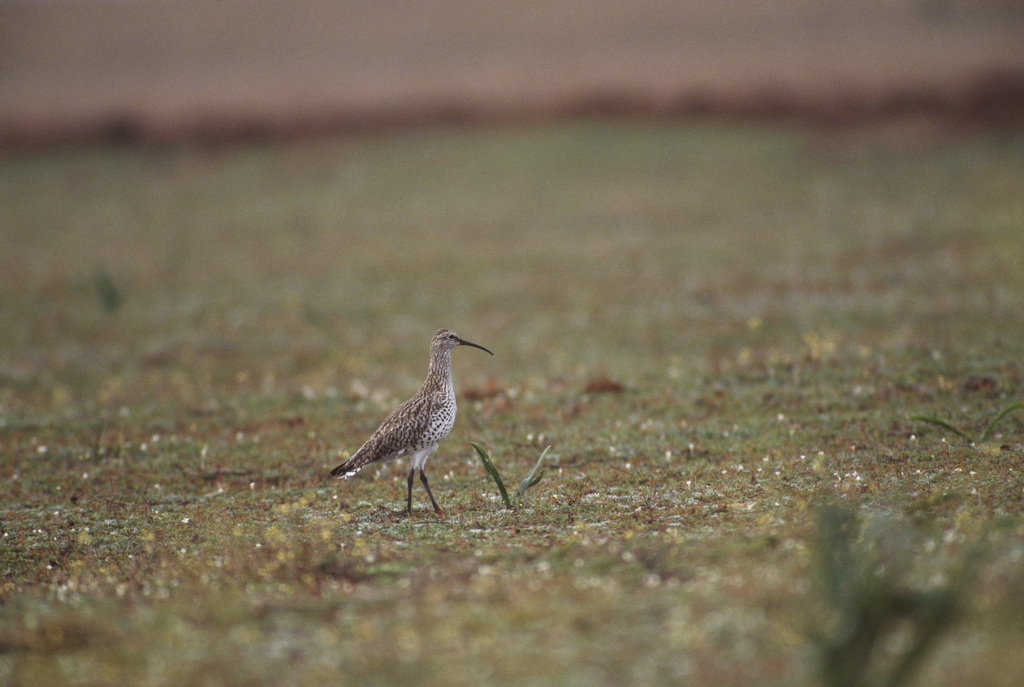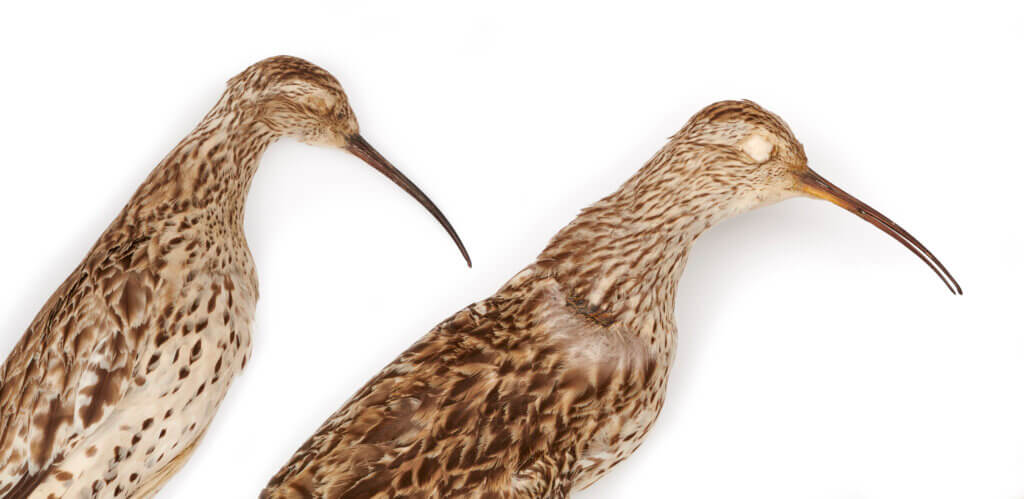Global extinction of a bird from mainland Europe and the Mediterranean confirmed by scientists

- This is the first known global bird extinction from mainland Europe, North Africa and West Asia.
- The last irrefutable sighting of the Slender-billed Curlew was in February 1995 in Morocco.
- This new study is a stark warning of the need to tackle the loss and degradation of inland grassland and wetland nesting areas and coastal wetland non-breeding areas, among other pressures, and the need for coordinated action to prevent further extinction of migratory waterbird species, including the Eurasian Curlew.
Scientists from the RSPB, BirdLife International (UK), Naturalis Biodiversity Center (The Netherlands) and Natural History Museum, London have today published an objective analysis that indicates the extinction of the Slender-billed Curlew, a migratory shorebird that bred in western Siberia and wintered in the Mediterranean.
The IUCN Red List currently recognises just 164 bird species as extinct, from over 11,000 species who have had their conservation status assessed by BirdLife International, the global Red List Authority for birds.
This marks the first known extinction of a bird species from mainland Europe, North Africa and West Asia* Extensive efforts have been made for decades to find evidence of the Slender-billed Curlew across its breeding and non-breeding ranges, but all have proven unsuccessful.
The paper, published today in the journal IBIS doi: 10.1111/ibi.13368, uses objective statistical analysis of threats to the species and a database of records, including museum specimens and sightings, to assess the likelihood of extinction. The analysis shows that there is a 99.6% chance that the bird no longer exists and went extinct around about the time of the last record in 1995.
Nicola Crockford, Principal Policy Officer for the RSPB, said: “This is one of the most fundamentally devastating stories to come out of nature conservation in a century and gets to the very heart of why the RSPB and BirdLife Partnership are doing what we do; that is, ultimately, to prevent extinction of species. This is the first known global extinction of a bird from mainland Europe, North Africa and West Asia. This has happened in our lifetimes. How can we expect countries beyond Europe to step up for their species when our comparatively wealthy countries have failed?
Extinction is forever. This news highlights that our work to save the Eurasian Curlew and Black-tailed Godwit, as well as many other migratory shorebirds that are of conservation concern, is of utmost urgency to prevent more species following the Slender-billed Curlew into extinction.”
Graeme Buchanan, Head of International Conservation Science with the RSPB, said: “Declaring a species extinct is not something that is done lightly and the IUCN who make the ultimate decision on extinction for the Red List of Threatened Species need full details of the status of a species before doing so. It’s important that it’s not done too soon, as this could lead to the removal of conservation efforts when they may still be beneficial; however, prolonged investment in an already extinct species could be a waste of limited resources. This means we can’t just assume a species is extinct if it hasn’t been seen for a while. This is particularly relevant for the Slender-billed Curlew, given its breeding grounds were never fully known, and the extensive distribution during the non-breeding season. By using objective, agreed methods we can make a robust assessment, but they do not make the outcome any less devastating. It is now up to IUCN to make the decision on the status of the species.”
The causes of the Slender-billed Curlew’s decline may never be fully understood, but possible pressures included extensive drainage of their raised bog breeding grounds for agricultural use, the loss of coastal wetlands used for winter feeding, and hunting, especially latterly, of an already reduced, fragmented and declining population. There could have been impacts from pollution, disease, predation, and climate change, but the scale of these impacts is unknown.
The Slender-billed Curlew was a close relative of the Eurasian Curlew, a shorebird whose bubbling call can be heard during the breeding season in British uplands and other grasslands such as the East Anglian Brecklands, and flocks of which can be seen across our estuaries through the winter months. The Eurasian Curlew is Near Threatened on the IUCN global and European Red Lists of Threatened Species and is on the UK’s Birds of Conservation Concern red list.
Nicola Crockford added: “The importance of coastal wetland non-breeding areas and upland, grassland and wetland breeding grounds cannot be overestimated, and the threats they face worldwide, should not be ignored. This is why we need governments, donors and other stakeholders to secure the ecological networks required by these birds along their flyways, including through beneficial agri-environment schemes and an end to inappropriate afforestation in the nesting areas, and protected, sustainably managed and restored coastal wetlands adapted to the impacts of sea level rise and other climate change related events; it is possible to have all these things to the benefit of local human communities as well as the birds.”
Dr Alex Bond, Senior Curator in Charge of Birds at the Natural History Museum, has been part of the team tracing the fate of the curlew.
He said: “When the Slender-billed Curlew stopped returning to their main wintering site at Merja Zerga, Morocco, there was quite a lot of effort put in to try to locate them on breeding grounds. Several expeditions, hundreds of thousands of square kilometres searched. And all this has turned up, unfortunately, is nothing.
As climate change continues, this is going to be the status quo. Things are not getting better for birds. Tackling climate change, habitat destruction and pollution is the best chance we’ve got at protecting them, at home and abroad.”
This news follows the recent announcement by BirdLife International that 16 other migratory shorebird species, four of which (Grey Plover, Turnstone, Dunlin, Curlew Sandpiper) are regular in the UK, have just been uplisted to higher threat categories on the IUCN Red List of Threatened Species, owing to population declines.
Alex Berryman, Red List Officer at BirdLife International, and a co-author of the study, said: “The devastating loss of the Slender-billed Curlew sends a warning that no birds are immune from the threat of extinction. More than 150 bird species have become globally extinct since 1500. Invasive species have often been the culprit, with 90% of bird extinctions impacting island species. However, while the wave of island extinctions may be slowing, the rate of continental extinctions is increasing. This is a result of habitat destruction and degradation, overexploitation and other threats. Urgent conservation action is desperately needed to save birds; without it we must be braced for a much larger extinction wave washing over the continents.”
Nicola Crockford concluded: “Migratory birds connect nations. Efforts by some countries to conserve a species can be undermined by damaging actions in other countries which share the same migratory species. Just as carbon in the atmosphere is a measure of international efforts to combat climate change, the status of migratory species is an indicator of the success of international efforts to conserve biodiversity. The extinction of the Slender-billed Curlew is as much a clarion call for greatly enhanced action for nature as the floods, fires and droughts devastating the planet are for action to combat climate change.”
The Natural History Museum is hosting an exhibition in collaboration with the RSPB, Birds: Brilliant and Bizarre, open until 5 January 2025, where the public can learn more about the dangers birds face and how to protect them, as well as their extraordinary evolutionary history and behaviours.
*(although two species have gone extinct from offshore islands in this region, the Great Auk in the mid-19th Century and Canary Island Oystercatcher in the mid-20th century).

ENDS
[registration_form]
What ever happened to the word sanctuary? Living in the same geographical area throughout my long life I have witnessed the effects of human population growth, a growing detachment from the natural world, and a ruthless change in attitude to land usage. A ruthless belief that all land must be exploited for the benefit of mankind, otherwise has no worth. Even some of the organisations professing conservation objectives, exploit their land for commercial gain, with redundant faded picture boards of now absent species. So called, nature reserves now resembling nothing more than a dog exercising public park, or as once witnessed, boats being hired out to get up close to the water fowl in one of the most valuable and prestigious RSPB west country sights. Have we forgotten how to conserve, with enough value attributed to what once was, a countryside full of rich sound and life, with space to survive and yes wildlife sanctuary, devoid of disturbance, that were just that.